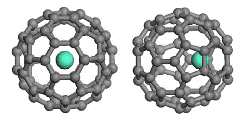Chemistry, Department of: Faculty Series

Xiao Cheng Zeng Publications
Document Type
Article
Date of this Version
2-22-2003
Abstract
Cooperative effects in a one-dimensional network of intermolecular bifurcated hydrogen bonding interactions are investigated by means of ab initio calculations. The trans–trans conformation of the diformamide molecule is used as a basic motif to model a chain of bifurcated H bonds. In this model system, the two proton–acceptor atoms belong to the same molecule. The one-dimensional network is modeled then by periodically stacking up to 12 molecules of the unit motif. Different indicators of H-bond strength such as energetic, structural, dielectric, vibrational frequencies, and isotropic chemicals shifts consistently show significant cooperative effects in the chains. The dissociation energy in the dimer is calculated to be 9.88 kcal/mol, while that of the strongest interaction in the decamer is calculated to be 26.12 kcal/mol (164% increase in cooperativity). Thus, although three-center H bonds can be viewed as a consequence of proton deficiency, in some cases they may also be viewed as the natural result of an interaction that is itself energetically favorable and capable of competing with the more conventional two-center H bonds. Natural bond orbital analysis reveals substantial charge delocalization within each molecule, and charge transfer along the chains. Interestingly, this charge delocalization makes the system a good candidate for resonance-assisted H bonding which in turn increases the covalent character of this type of bifurcated H-bonding interaction.


Comments
Published by American Institute of Physics. J. Chem. Physics VOLUME 118, NUMBER 8, 22 FEBRUARY 2003. ©2003 American Institute of Physics. Permission to use. http://jcp.aip.org/.